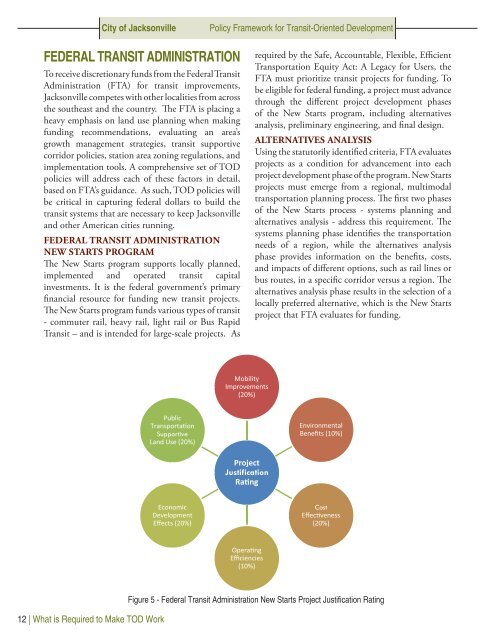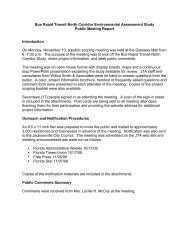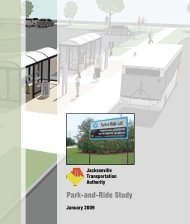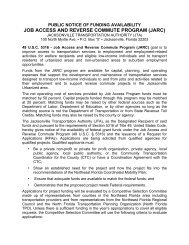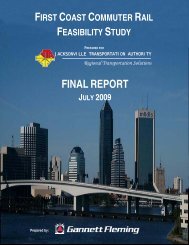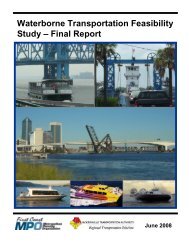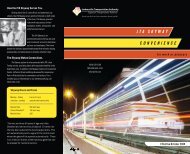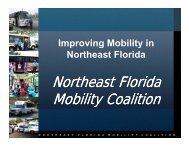Policy Framework - Jacksonville Transportation Authority
Policy Framework - Jacksonville Transportation Authority
Policy Framework - Jacksonville Transportation Authority
Create successful ePaper yourself
Turn your PDF publications into a flip-book with our unique Google optimized e-Paper software.
City of <strong>Jacksonville</strong><br />
<strong>Policy</strong> <strong>Framework</strong> for Transit-Oriented Development<br />
Federal Transit Administration<br />
To receive discretionary funds from the Federal Transit<br />
Administration (FTA) for transit improvements,<br />
<strong>Jacksonville</strong> competes with other localities from across<br />
the southeast and the country. The FTA is placing a<br />
heavy emphasis on land use planning when making<br />
funding recommendations, evaluating an area’s<br />
growth management strategies, transit supportive<br />
corridor policies, station area zoning regulations, and<br />
implementation tools. A comprehensive set of TOD<br />
policies will address each of these factors in detail,<br />
based on FTA’s guidance. As such, TOD policies will<br />
be critical in capturing federal dollars to build the<br />
transit systems that are necessary to keep <strong>Jacksonville</strong><br />
and other American cities running.<br />
Federal Transit Administration<br />
New Starts Program<br />
The New Starts program supports locally planned,<br />
implemented and operated transit capital<br />
investments. It is the federal government’s primary<br />
financial resource for funding new transit projects.<br />
The New Starts program funds various types of transit<br />
- commuter rail, heavy rail, light rail or Bus Rapid<br />
Transit – and is intended for large-scale projects. As<br />
required by the Safe, Accountable, Flexible, Efficient<br />
<strong>Transportation</strong> Equity Act: A Legacy for Users, the<br />
FTA must prioritize transit projects for funding. To<br />
be eligible for federal funding, a project must advance<br />
through the different project development phases<br />
of the New Starts program, including alternatives<br />
analysis, preliminary engineering, and final design.<br />
Alternatives Analysis<br />
Using the statutorily identified criteria, FTA evaluates<br />
projects as a condition for advancement into each<br />
project development phase of the program. New Starts<br />
projects must emerge from a regional, multimodal<br />
transportation planning process. The first two phases<br />
of the New Starts process - systems planning and<br />
alternatives analysis - address this requirement. The<br />
systems planning phase identifies the transportation<br />
needs of a region, while the alternatives analysis<br />
phase provides information on the benefits, costs,<br />
and impacts of different options, such as rail lines or<br />
bus routes, in a specific corridor versus a region. The<br />
alternatives analysis phase results in the selection of a<br />
locally preferred alternative, which is the New Starts<br />
project that FTA evaluates for funding.<br />
Mobility<br />
Improvements<br />
(20%)<br />
Public<br />
<strong>Transportation</strong><br />
Supportive<br />
Land Use (20%)<br />
Environmental<br />
Benefits (10%)<br />
Project<br />
Justification<br />
Rating<br />
Economic<br />
Development<br />
Effects (20%)<br />
Cost<br />
Effectiveness<br />
(20%)<br />
Operating<br />
Efficiencies<br />
(10%)<br />
12 | What is Required to Make TOD Work<br />
Figure 5 - Federal Transit Administration New Starts Project Justification Rating


